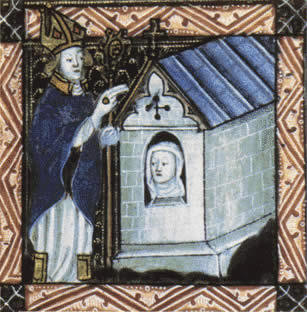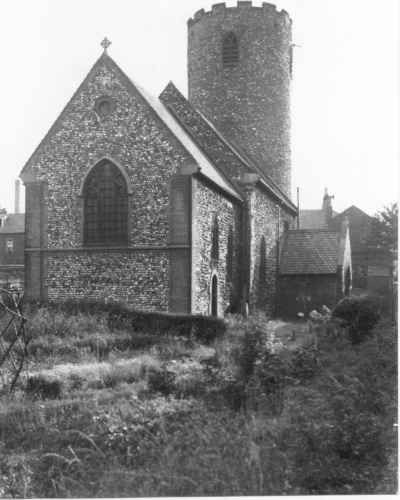

Sarah Stanbury's overview:
anchorite An anchorite or anchoress was a person who separated him or herself from society in order to devote a life to penance and prayer in solitude. Anchorites were similar to hermits, but their location was invariably within populated communities, not the desert or forest location of the traditional hermit. They could be members of religious orders but they also could be solitary individuals who chose to live an ascetic life marked by permanent enclosure in a building or part of a building (an anchorage or anchorhold) attached to a religious foundation. The highly popular guide for the female anchorite, the 13th-century Ancrene Wisse, outlined a liturgical day with a series of prayers, some in the vernacular, more simple than that of the Benedictine rule, and gave many rules for conduct. Chief among them was scrupulous observation of chastity and limited contact with the outside world. An example of an anchoress is Julian of Norwich (1342-{1416-1423}) who lived in an anchoritic cell at St. Julianís church in Norwich. See anchorite's cell attached to the south choir of All Saints Church, King's Lynn.
Bibliography
Anchoritic Spirituality: Ancrene Wisse and Associated Works, trans. Anne Savage and Nicholas Watson. Paulist Press: Mahwah, NJ, 1991;
Gilchrist. Roberta. Gender and Material Culture: The Archaeology of Medieval Women. Routledge: London, 1994, see "Anchorages," 177-181.
Robertson, Elizabeth. Early English Devotional Prose and the Female Audience. Knoxville: University of Tennessee Press, 1990.
Warren, Ann. Anchorites and their Patrons in Medieval England. Berkeley: University of California Press, 1985.
Background from Norton Anthology online: http://www.wwnorton.com/nael/middleages/topic%5F1/ancrene.htm
An overview of the entire text from the Hermitary online: http://www.hermitary.com/articles/ancrene.html
 Introduction to Bob Hasenfratz's new edition of Ancrene Wisse:
http://www.lib.rochester.edu/camelot/teams/awintro.htm and the
Bibliography to his edition:
http://www.lib.rochester.edu/camelot/teams/awintro.htm#bib
Introduction to Bob Hasenfratz's new edition of Ancrene Wisse:
http://www.lib.rochester.edu/camelot/teams/awintro.htm and the
Bibliography to his edition:
http://www.lib.rochester.edu/camelot/teams/awintro.htm#bib
Deborah Schwartz's study guide to Ancrene Wisse at Cal Poly University: http://cla.calpoly.edu/~dschwart/engl512/ancrene.html
Online Literary Encyclopedia overview of Ancrene Wisse: http://www.litencyc.com/php/sworks.php?rec=true&UID=6649
There is a great essay on Anchoritic Spirituality on the Geocities website of someone who calls herself the Technocrone. Her name is Marsha Waggoner, a Ph.D. student at the University of Arizona; check out the essay "Anchoritic Spirituality in Medieval England: The Form, the Substance, the Rule" at http://www.geocities.com/Wellesley/Garden/3741/papers/awtext.htm.
I just found this fabulous website with lots of illustrations of the St. Alban's Psalter, a manuscript created for the Anglo-Saxon anchoress Christina of Markyate. There is a bio and a lot of illustrations at http://www.abdn.ac.uk/stalbanspsalter/english/essays/introduction.shtml.
The Church of St. Julian in Norwich--before its destruction in WWII:


The current webpage for the church describes the restoration after the war in
this manner:

Thus did it remain until nearly ten years later, when work was put in hand to clear away the rubble and rebuild the church. As much as possible of the surviving fabric was retained, in particular the north wall of the nave with its circular Norman window. A fifteenth-century font brought from the redundant All Saintsí church took the place of that which had been broken beyond repair, while a Norman doorway from the neighbouring church of St Michael-at-Thorn, gutted during the same raid, replaced one of similar date, which had been sketched and etched by John Sell Cotman. This now gives access from the nave to a sacristy built on foundations, laid bare in 1906, of what was thought at the time to have been the cell of Dame Julian, the fourteenth-century anchoress or religious recluse, famous for the series of visions vouchsafed to her. Descriptions of these visions have been published in several editions under the title of Revelations of Divine Love.
www.the-plunketts.freeserve.co.uk/ KingStreet.htm
http://mysite.wanadoo-members.co.uk/the_plunketts3/Mediaevalcitychurches30.jpg
http://mysite.wanadoo-members.co.uk/the_plunketts3/Mediaevalcitychurches00.jpg